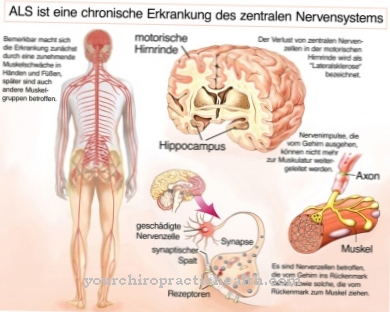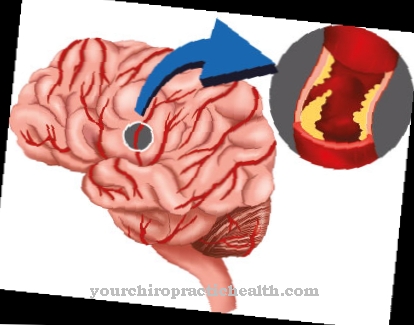The Tourniquet syndrome is a life-threatening complication that can occur after reperfusion of a body part that was previously tied off for a long time. It can include shock, cardiac arrhythmias, and irreversible kidney damage.
What is tourniquet syndrome?

© pixdesign123 - stock.adobe.com
The Tourniquet syndrome is also known as Reperfusion trauma designated. It occurs when a part of the body that has had insufficient or no blood supply for several hours is reconnected to the circulatory system.
The tolerance time during which ischemia (reduced blood flow) can exist without subsequently causing tourniquet syndrome is on average about 6 hours. The exact tolerance time is very different from one individual to another.
Tourniquet syndrome got its name from the tourniquet ligature, a surgical device that was previously used to tie off large vascular trunks.
causes
The Tourniquet syndrome initially seems paradoxical: the layman intuitively thinks that the restored blood flow to a previously undersupplied part of the body is not threatening, but saving.
The problem is that prolonged ischemia in the ligated limb unbalances the metabolism. Through reperfusion, pathological metabolic products are washed into the rest of the organism and can cause damage there. In particular, in the area affected by lack of oxygen, acidosis (acidosis) occurs due to increased formation of lactate.
There are more oxygen radicals that can cause cell damage. After a certain time, rhabdomyolysis sets in, i.e. H. a dissolution of striated muscle tissue. Dying cells can cause a. Potassium and myoglobin free. The released particles in the extracellular space cause edema, which in turn damages the surrounding tissue due to increased pressure.
For the danger to life with tourniquet syndrome, v. a. Potassium is responsible: if it is distributed throughout the organism after reperfusion and causes systemic hyperkalaemia, there is a risk of cardiac arrhythmias up to and including cardiac arrest.
Typical symptoms & signs
- Necrosis, ischemia
- Hyperkalemia
- Acidosis (acidosis)
- Cardiac arrhythmias
- Kidney failure
- Cardiac arrest (cardiovascular failure)
Diagnosis & course
The existence Tourniquet syndrome can be recognized by the extremity that is still tied: the progressive tissue damage is noticeable through swelling, reddening and overheating. After reperfusion there is almost always generalized edema and a resulting volume deficiency shock with typical signs of shock such as paleness, a drop in blood pressure and an increased heart rate.
The shock index is positive. Pain as well as sensory and motor deficits occur on the previously tied limb. The diagnosis of tourniquet syndrome is supported by laboratory findings: The patient's blood shows severe metabolic acidosis and elevated potassium levels. The released myoglobin can also cause kidney damage and even acute kidney failure. A dark brown color of the urine and myoglobinuria indicate a threat to the kidney.
Complications
Tourniquet syndrome is already a serious complication that, if left untreated, can lead to death. Typical consequences of the syndrome include necrosis and ischemia. There is a risk that the tied part of the body will die off completely and will have to be amputated. Serious cardiovascular problems and circulatory disorders are usually associated with such necrosis.
It can also lead to kidney failure and, in the worst case, to cardiac arrest. Acidosis can also occur, an over-acidification of the blood that is associated with low blood pressure, headache, shortness of breath and hyperventilation. The reperfusion can be followed by the development of edema, usually associated with a volume deficiency shock and severe shock symptoms such as a drop in blood pressure and tachycardia.
Tourniquet syndrome is always associated with pain and sensory and motor deficits. Treating the syndrome also carries risks. Dialysis carries the risk of further cardiovascular problems. Infections or injuries at the site of the puncture cannot be ruled out either.
Most of the time, the patient is prescribed relatively strong pain relievers, which can lead to side effects. Allergy sufferers can experience allergic reactions through to anaphylactic shock. Interactions with other drugs cannot be ruled out either.
When should you go to the doctor?
Tourniquet syndrome is a medical emergency. The person concerned must be treated immediately by a doctor. Symptoms of necrosis or hyperkalemia suggest a reperfusion trauma and require clarification. The syndrome can occur as a result of previous illnesses or in connection with an accident or fall. If it is suspected that an extremity is not receiving sufficient blood supply, either the blood flow must be restored or a doctor must be called in. Symptoms such as swelling or redness suggest reperfusion.
Generalized edema and typical signs of shock such as paleness, a drop in blood pressure or an increased heart rate appear later. A dark brown color of the urine indicates an impending kidney damage as a result of released myoglobins. The symptoms mentioned are clear warning signs that need to be clarified immediately. The right contact person is the family doctor or, in the case of acute complaints, the emergency services. The patient must be treated in a hospital and, depending on the cause, visit other specialists such as an orthopedic surgeon or cardiologist.
Treatment & Therapy
Treatment of the Tourniquet syndrome initially focuses on combating the life-threatening hypovolemic shock and cardiac arrhythmias. Metabolic acidosis can be counteracted by hyperventilation; it may also be buffered by bicarbonate.
In order to preserve the kidney, massive volume administration and possibly hemofiltration may be necessary. The success of the treatment depends crucially on how early the reperfusion of the affected body part takes place. If the ischemia lasts too long and the tissue damage is too severe, only amputation can prevent the patient's death.
In the case of therapy within the first 4 hours after ischemia, the amputation rate is only four percent; after at least 12 hours of ischemia, 30 to 50 percent of the cases have to be amputated. Modern intensive care measures have increased the chances of surviving tourniquet syndrome significantly, but the threat posed by this clinical picture should not be underestimated. In the case of tourniquet syndrome after ischemia of the lower extremity, the fatality rate is still given in the literature at up to 20 percent.
prevention
The best prevention one Tourniquet syndrome is never to tie a part of the body longer than absolutely necessary. If tying cannot be avoided due to the risk of blood loss, it is helpful to cool the affected extremity down before reperfusion - this reduces certain enzyme activities and results in less harmful metabolic products. In long-term ischemia, amputation is the only way to save the rest of the organism from tourniquet syndrome.
You can do that yourself
In certain cases, self-treatments cure or alleviate the symptoms. Well-tried recipes that have been handed down over generations save the consultation of a doctor. However, this form of therapy is not suitable for life-threatening conditions such as tourniquet syndrome. Acute medical treatment is inevitable for this disease. An intensive medical monitoring follows regularly. If the extremity cannot be saved, it usually has to be amputated. Patients then continue to live with functional impairments.
Those affected can only prevent in a small way and thus rule out the cause of a tourniquet syndrome. You have to make sure that a part of the body is never tied off longer than necessary. Tourniquet syndrome is a great danger, especially in small children, because they cannot articulate themselves sufficiently, which means that parents cannot identify the actual cause of the pain. Even hair caught in the socks can cause the loss of a toe.
Tourniquet syndrome sometimes brings with it suspicion of abuse. Because strangulation can result from a criminal act. Those affected should therefore sound out the causes of tourniquet syndrome extensively and contact the local police station if they suspect it.




























